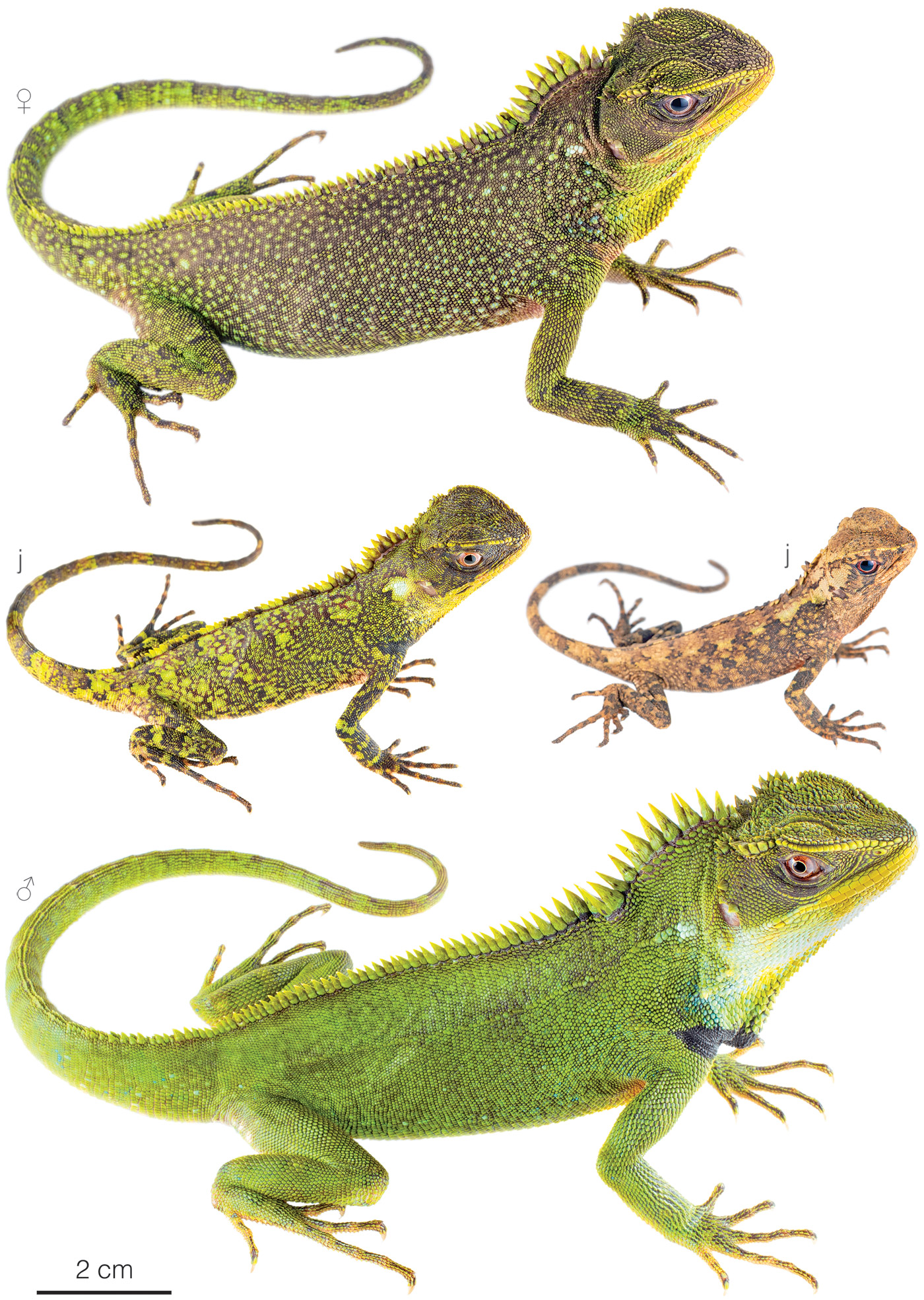Published July 31, 2023. Updated December 2, 2023. Open access. | Purchase book ❯ |
Brown-eyed Woodlizard (Enyalioides altotambo)
Reptiles of Ecuador | Sauria | Hoplocercidae | Enyalioides altotambo
English common names: Brown-eyed Woodlizard, Brown-eyed Dwarf-Iguana, Alto Tambo Woodlizard.
Spanish common names: Lagartija de palo de Alto Tambo, iguana enana de ojos cafés.
Recognition: ♂♂ 34.1 cmMaximum distance from the snout to the tip of the tail. Snout–vent length=14.7 cm. ♀♀ 30.9 cmMaximum distance from the snout to the tip of the tail. Snout–vent length=13.4 cm..1,2 Enyalioides altotambo can be distinguished from other lizards in its area of distribution by having a green coloration, granular dorsal scales, a strongly projected spiny vertebral crest, and a skull roof (casque head flattened at the top).1,2 The species is unique among its congeners in northwestern Ecuador in having brown eyes and lacking a pale vertical line above the arm (Fig. 1). The most similar species is E. oshaughnessyi, but this other dwarf iguana has bright red eyes and occurs south of the known range of E. altotambo.1

Figure 1: Individuals of Enyalioides altotambo from Canandé Reserve, Esmeraldas province, Ecuador. j=juvenile.
Natural history: Enyalioides altotambo is a locally frequent lizard that is difficult to observe during the daytime due to its intricate green camouflage. This species occurs in pristine lowland rainforests and prefers to dwell along streams.1,3 Although diurnal, Brown-eyed Woodlizards are usually found at night, roosting on stems and tree trunks 0.2–3 m above the ground.1,3 They tend to sleep close to their den, a hole in the ground to which they retreat if disturbed.3 Individuals of E. altotambo avoid predators by staying still and blending against the vegetation or by moving up and around trunks.3
Conservation: Endangered Considered to be facing a high risk of extinction in the near future..4 Enyalioides altotambo is listed in this category primarily on the basis of the species’ limited extent of occurrence (here estimated to be ~10,651 km2) in an area having the highest rate of deforestation in Ecuador.5 At the time of the assessment, the species was known only from two localities. Now, 14 localities are known (Appendix 1), but deforestation caused by timber extraction and the expansion of the agricultural frontier continues to affect all of them. Fortunately, E. altotambo is a protected reptile in three private reserves.
Distribution: Enyalioides altotambo is endemic to an area of approximately 10,651 km2 in the Chocoan lowlands of northwestern Ecuador in Esmeraldas and Imbabura provinces (Fig. 2).

Figure 2: Distribution of Enyalioides altotambo in Ecuador. The star corresponds to the type locality: Alto Tambo, Esmeraldas province. See Appendix 1 for a complete list of the presence localities included in the map.
Etymology: The generic name Enyalioides, which comes from the Latin words Enyalius (a genus of neotropical lizards) and the suffix oides (=similar to), refers to the similarity between lizards of the two genera. The specific epithet altotambo refers to Alto Tambo, a village on the Ibarra–San Lorenzo road where E. altotambo was discovered.1
See it in the wild: Brown-eyed Woodlizards are usually found in closed-canopy situations rather than in open or semi-open areas. At Canandé and Otokiki reserves, these lizards are relatively easily to spot along forest trails at night, as their bright green coloration shines against the black night when lit with a flashlight.
Author: Alejandro ArteagaaAffiliation: Fundación Khamai, Reserva Arlequín, Ecoruta Paseo del Quinde km 56, Santa Rosa de Mindo, Pichincha 171202, Ecuador.
Photographers: Jose VieirabAffiliation: Tropical Herping (TH), Quito, Ecuador.,cAffiliation: ExSitu, Quito, Ecuador. and Alejandro ArteagaaAffiliation: Fundación Khamai, Reserva Arlequín, Ecoruta Paseo del Quinde km 56, Santa Rosa de Mindo, Pichincha 171202, Ecuador.
How to cite? Arteaga A (2023) Brown-eyed Woodlizard (Enyalioides altotambo). In: Arteaga A, Bustamante L, Vieira J (Eds) Reptiles of Ecuador: Life in the middle of the world. Available from: www.reptilesofecuador.com. DOI: 10.47051/MJYQ9166
Literature cited:
- Torres-Carvajal O, Venegas PJ, de Queiroz K (2015) Three new species of woodlizards (Hoplocercinae, Enyalioides) from northwestern South America. ZooKeys 494: 107–132. DOI: 10.3897/zookeys.494.8903
- Reyes-Puig C, Yánez-Muñoz MH (2015) Nuevos registros de la lagartija Enyalioides altotambo Sauria: Hoplocercidae) en Ecuador. Avances en Ciencias e Ingeniería 7: 8–12.
- Field notes, Reptiles of Ecuador book project.
- Brito J, Reyes-Puig C, Sánchez J (2021) Enyalioides altotambo. The IUCN Red List of threatened species. Available from: www.iucnredlist.org. DOI: 10.2305/IUCN.UK.2021-2.RLTS.T89929498A89929559.en
- MAE (2012) Línea base de deforestación del Ecuador continental. Ministerio del Ambiente del Ecuador, Quito, 30 pp.
Appendix 1: Locality data used to create the distribution map of Enyalioides altotambo in Ecuador (Fig. 2). Go to the section on symbols and abbreviations for a list of acronyms used. Asterisk (*) indicates type locality.
| Country | Province | Locality | Source |
| Ecuador | Esmeraldas | Agua Clara de Los Chachis | iNaturalist; photo examined |
| Ecuador | Esmeraldas | Canandé Biological Reserve | Reyes-Puig & Yánez-Muñoz 2015 |
| Ecuador | Esmeraldas | Charco Vicente | Morales 2004 |
| Ecuador | Esmeraldas | Durango | Photo by Morley Read |
| Ecuador | Esmeraldas | Gualpi | Reptiles of Ecuador book database |
| Ecuador | Esmeraldas | Itapoa Reserve | Reptiles of Ecuador book database |
| Ecuador | Esmeraldas | Lita–San Lorenzo road | iNaturalist; photo examined |
| Ecuador | Esmeraldas | Lote Rosero | Reptiles of Ecuador book database |
| Ecuador | Esmeraldas | Otokiki Reserve* | Torres-Carvajal et al. 2015 |
| Ecuador | Esmeraldas | Río Balthazar | Torres-Carvajal et al. 2023 |
| Ecuador | Esmeraldas | Río Bogotá | Reyes-Puig & Yánez-Muñoz 2015 |
| Ecuador | Esmeraldas | Tangareal | Morales 2004 |
| Ecuador | Imbabura | Lita | iNaturalist; photo examined |
| Ecuador | Imbabura | Palma Real | Morales 2004 |